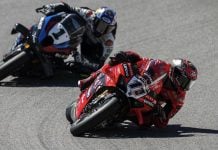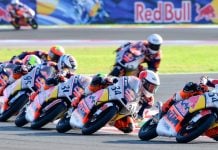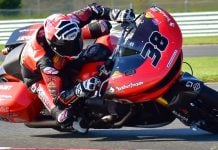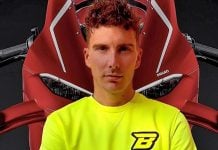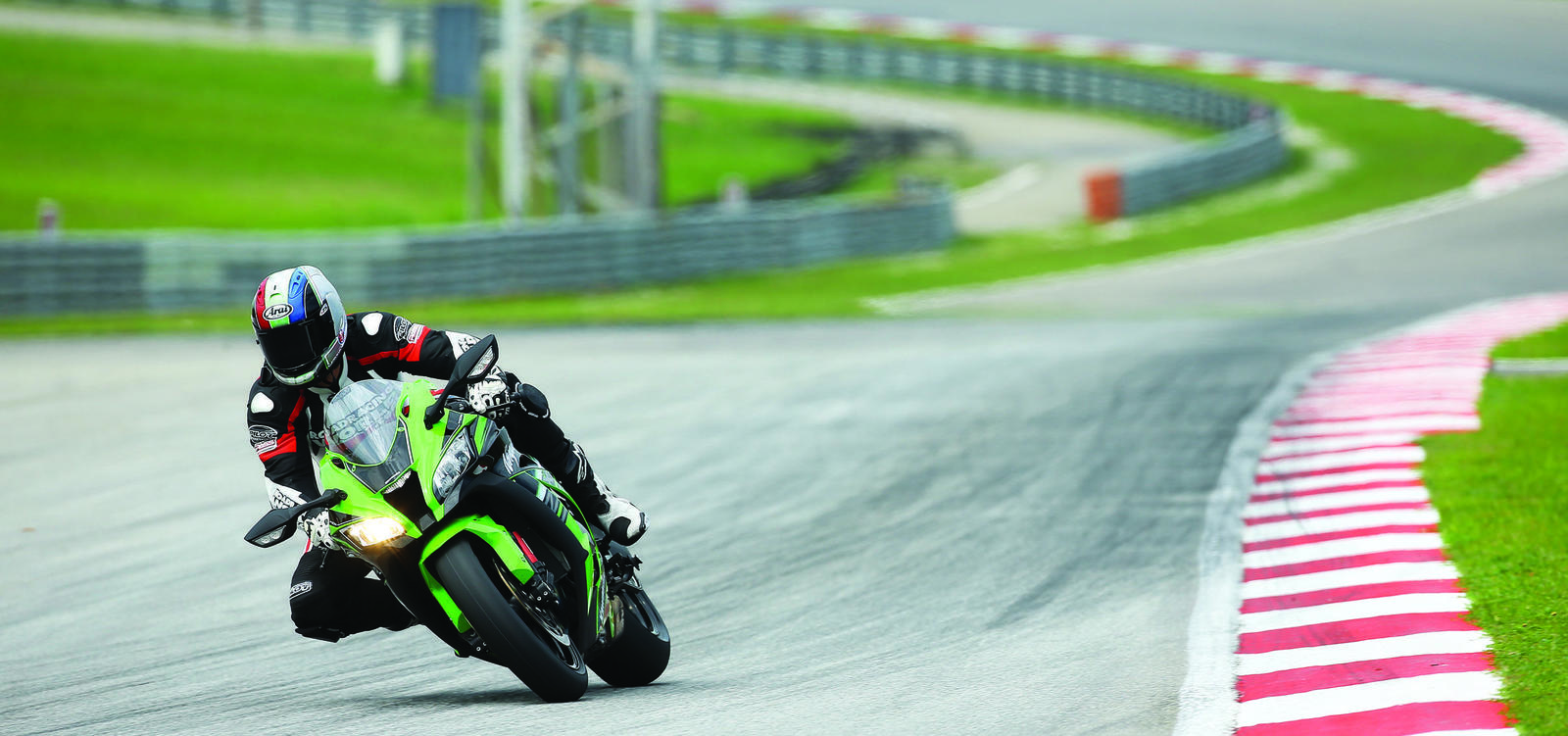“A Fast Bike On The Track Is An Easy Bike To Ride”
– ZX-10R Project Leader Yoshimoto Matsuda
To read more articles like this March 2016 test ride please subscribe to Roadracing World.
By Chris Ulrich
The way Project Leader Yoshimoto Matsuda explains it, the “Get Closer” slogan used for the introduction of the 2016 Kawasaki ZX-10R invites riders to get a machine that is actually closer to a winning World Superbike than anything else on the market. Matsuda talks about using “real parts, real suspension, real brakes, real engine and real electronics.”
When he says “real parts,” what he means is race-quality, track-proven components that will help his latest creation’s performance stand up—holding its value and its owner’s interest—for years to come. In this case the “real parts” include cast Brembo Monoblock M50 brake calipers with four 30mm pistons, paired with a Brembo radial pump master cylinder, braided stainless-steel lines and 330mm Brembo front discs. The parts also include Showa’s new, top-of-the-line gas-charged 43mm Balance Free Forks and a Balance Free Rear Cushion-Lite shock absorber, a lighter-weight version of the BFRC first seen on the 2012 Honda CBR1000RR.
Matsuda and his project team worked closely with the Kawasaki Racing Team to build a new model—based on the previous model ZX-10R—that can continue to win races in the Superbike World Championship under increasingly restrictive, production-focused rules imposed by the FIM. The development path didn’t include any cost-cutting measures and the 2016 ZX-10R is a serious track machine; the Kawasaki engineers even built in the capability to change rake angle using optional steering head inserts, sold as racing kit parts. The swingarm pivot is also adjustable, using optional racing kit parts. The available racing parts aren’t limited to the chassis; Kawasaki will also stock and sell a host of engine and electronics parts for racers, starting in February 2016.
Being the second Japanese manufacturer to come to the market with a sportbike equipped with the latest advanced electronics gave Kawasaki engineers the opportunity to benchmark their new offering against the BMW S1000RR and the Yamaha YZF-R1. Maybe it’s Japanese rivalry or the fact the Yamaha has been so successful since the new YZF-R1 was released, but Matsuda seemed most focused on beating the Yamaha. At lunch after the official tech briefing, Matsuda gathered the journalists and brought up a dyno graph on his laptop computer, comparing the power curves of the new ZX-10R, the Yamaha YZF-R1, and the BMW S1000RR.

The graph showed that the BMW made significantly more horsepower than the Yamaha and the Kawasaki between 5,000 to 7,000 rpm, but Matsuda said that having more power in that rpm range just increases problems with wheelies and doesn’t drive the bike forward. (When we tested the Yamaha and the BMW on a dyno for our comparison test in the July 2015 issue, the BMW made 6.57 bhp more than the Yamaha at 5,000 rpm and 19.76 bhp more than the Yamaha at 7,000 rpm; at 8,000 rpm the advantage is back to 7.3 bhp and at 8,500 the Yamaha is within 3.4 bhp of the BMW.) On Matsuda’s chart—which he did not let journalists have or photograph—the power curves for the Yamaha and the new Kawasaki were very close throughout the mid-range, with the Kawasaki gaining an advantage above 8,000 rpm and making about four more horsepower at peak power. If the data is correct, the new ZX-10R’s stock power output places it between the Yamaha and the BMW in terms of peak power.
Matsuda said that he concentrated his efforts on making the latest ZX-10R easier to ride on the racetrack, with sweet handling and user-friendly power delivery without sacrificing top-end power. Emphasis was placed on building a bike that had the right balance between handling and power to allow riders of all skill levels to turn faster lap times with less effort. “A fast bike on the track is an easy bike to ride,” Matsuda added.
I agree with Matsuda, because on the racetrack, making your bike easier to ride can make the difference between winning and losing races, no matter what level you’re competing it.
The result—a high-performance, balanced package with usable power, high-end components, and pricing that starts at $14,999—should give the new ZX-10R staying power on the racetrack and in the marketplace.
Many of the new ZX-10R’s tech details were covered on pages 8-9 of the December 2015 issue of Roadracing World. But we did learn more about the bike’s technical features and functionality at Sepang.
Summarizing the main features, the 2016 model features the same inline four-cylinder engine used in the previous model, with a bore and stroke of 76mm x 55mm with a compression ratio of 13.0:1. The valve train features titanium valves, with the exhaust valve diameter increased to 25.5mm. Cam timing has been changed on the intake side to open at 45 degrees BTDC and close at 76 degrees ABDC, and duration is now 306 degrees. On the exhaust side, the valves open at 77 degrees BBDC and close at 49 degrees ATDC with a duration of 306 degrees. Overlap has increased 19 degrees, to 94 degrees. Increasing the overlap moved the power up in the rpm, which Matsuda said helped Kawasaki engineers create a bike with more drivability and less tendency to wheelie, while also increasing top-end power.
A big change for the 2016 model is a 1.0-pound lighter crankshaft—with smaller counterweights—which reduces moment of inertia by 20%; Matsuda said the engineers worked on the sweet spot for crankshaft weight to find the right balance of manageable power delivery, while also reducing the inertia to help improve braking stability, turning, and flickability. Another big change—an adaptation to FIM Superbike rules now limiting the number of optional transmission ratios—is the addition of a standard close-ratio gearbox. The first and second gear ratios in the cassette transmission are now closer together, and all the internal gear ratios are shorter. The actual first-gear ratio is unchanged, but the ZX-10R has always had a first gear that can be used in slower corners on a racetrack, improving drive.
The engine has been moved higher up and farther forward in the twin-spar aluminum frame, which has flex characteristics optimized for World Superbike. Placing the engine higher in the chassis and farther forward—Matsuda wouldn’t reveal by how much—moves the center of gravity up and forward, making it easier to change direction but also adding to the pitch encountered at corner entry. The distance from the seat to the steering stem has been reduced by 7.5mm (it’s now 28 inches, or 711mm from the center of the seat to the center of the steering stem), moving the rider’s weight farther forward in an effort to improve front-end feel. A new swingarm is 15.8mm longer and features increased rigidity and more fore-and-aft axle adjustability than the swingarm on the previous model ZX-10R. Using a longer swingarm also effectively lowered the pivot position slightly. The rear linkage has also been changed, to be slightly more progressive.
Like the latest open-class sportbikes from Aprilia, BMW, Ducati and Yamaha, the new ZX-10R has advanced electronics based on an Inertial Measurement Unit, or IMU. (Yamaha has its own, in-house-developed IMU, while the competing brands use a Bosch IMU.)
The ZX-10R’s three-axis Bosch IMU is mounted on the airbox at a 45-degree angle, meaning the IMU is orientated at 45 degrees to the ground when the ZX-10R is upright and static. The IMU measures five dynamics(which Kawasaki calls “freedoms”)—longitudinal acceleration, transverse acceleration, vertical acceleration, roll rate and pitch rate. Kawasaki defines longitudinal acceleration as covering acceleration and braking; transverse acceleration as covering side-to-side movement, or cornering; vertical acceleration as covering up/down movement as when cresting a hill at a steady speed; roll rate as covering angular rotation or change in lean angle during the transition from upright to leaned over; and pitch rate as covering transverse angular rotation or front lift or wheelie under acceleration and dive and rear lift under braking.
Kawasaki’s own, patent-pending proprietary ECU software uses IMU input to calculate what it calls the sixth “freedom”—yaw rate, or rotation around the vertical axis during cornering, including getting sideways as the rear wheel steps out under acceleration. Based on input from the IMU and from throttle position, wheel speed and gear position sensors as well as its own calculations, the ECU controls the ride-by-wire throttle opening, ignition timing and the hydraulic brake pressure on units fitted with the optional KIBS (Kawasaki Intelligent anti-lock Braking System, the brand’s version of advanced ABS).
Placing the IMU at a 45-degree angle allows better measurement of pitching forces created during braking and acceleration. When the brakes are applied the angle goes closer to zero, which allows for better calculation of the KIBS function. Acceleration moves the IMU back toward 45 degrees, determining rearward pitch for the S-KTRC (Sport Kawasaki TRaction Control) system’s wheelie-control function. When the value goes over 45 degrees it means the bike is starting to wheelie.
The ZX-10R’s S-KTRC system uses input from the IMU along with wheel-speed sensors, the throttle position sensor and crank position sensor to determine when conditions are about to become unfavorable—including wheel spin or wheelies—and then removes power using a combination of closing the throttle valves and making ignition cuts. It’s a matter of physics: The motorcycle can only accelerate at a certain rate depending on lean angle and pitch rates, so the ECU will remove power before certain parameters are exceeded. The amount of power removed is determined by the traction control setting, with five levels available depending on the surface conditions and rider skill. The system uses the same inputs to determine when wheelie conditions are present, then removes power by closing the throttle valves and cutting ignition. Kawasaki’s system still allows front lift-off, but limits any wheelie to a few inches to provide the best acceleration based on the forces applied to the bike.

The Sepang International Circuit has two fast straightaways, four hard-braking zones, a couple of fast sweepers and switchbacks and one long, fast sweeper where it’s possible to spin the rear tire enough to get into the traction control. Add in oppressive heat, snakes crossing the track and a lizard that liked to loiter outside of Turn Three and you have the makings of an exciting day at the racetrack!
Kawasaki brought two different versions of the ZX-10R for the assembled journalists to ride. Everybody started out on a stock bike with a few suspension setting changes before getting a session on a ZX-10R fitted with a pre-mapped racing kit ECU (which Kawasaki sells for $1729.95 including a communication cable and wire harness), and an Akrapovic exhaust system, which together produce about another 10 horsepower. But well before we would get to the session aboard the fast(er) version, we spent a reconnaissance session on a standard ZX-10R fitted with the optional KIBS ABS system and with the traction control turned up to Level 2.
The stock (non-kit) bikes had racetrack set-ups developed by Kawasaki test riders, including the standard front preload setting (six turns in from full out), the standard rebound setting (2.5 turns out from full in) and a less-than-standard compression damping setting (2.75 turns out from full in, compared to the standard 3.5 turns from full in). At the rear, the ride height was raised 1mm using a shim underneath the shock clevis. The rear rebound was increased (to 1.5 turns from full in, compared to the standard setting of 2.25 turns from full in) and the compression setting was the same as stock at 1.0 turns from full in.
I noticed the new riding position as I rolled out of the pits and made my first few laps. With the steering head located 7.5mm closer to the seat, the seat height increased by 23mm, the handlebars raised by 13mm and the footpegs raised by 19mm, my weight was moved up and forward over the front of the bike, making it easier to turn the ZX-10R into the corners. But being 6’ tall, I found that the shorter distance from the seat to the handlebars made me bend my arms more when I was in the riding position, placing more pressure on my biceps and shoulders in Sepang’s long braking zones—I squeezed the fuel tank with my knees to help alleviate the pressure. A side effect of the new bar position was a reduced amount of room to get my elbows in front of my knees while tucking in, and I had to lift my butt up on top of the passenger seat to reach full tuck. Once tucked in, the taller front windscreen and wider fairing provided great wind protection on the long straights, and the higher footpegs give the ZX-10R 10mm more cornering clearance.

During the first session—which would be the only one I got on a KIBS bike, with the KIBS activated—I focused on understanding the performance of the KIBS system. Unlike the ABS systems I’ve tried on other bikes, the KIBS doesn’t produce pulsing felt in the brake lever when the system is reducing brake pressure to avoid a front-wheel skid. And the KIBS system does not suddenly decrease braking power in the middle of the braking zone; the lever stayed consistent during the entire session. But (as I would confirm later in the day when I rode a bike with KIBS deactivated), overall stopping power was reduced with the KIBS activated, which meant I had to apply the brakes earlier as I approached a corner. I tried increasing the brake pressure by snatching and burying the lever, but it didn’t change the longer distance required to get slowed down for a corner. The KIBS also feels like it slightly reduces power as you start to lean the bike over and enter a corner.
For the second session, I rode the same bike, but with the KIBS deactivated using a plug-in dongle from the racing kit; I also turned the S-KRTC from Level 2 down to Level 1, for less intervention, because I felt the system was removing too much power in some of the acceleration zones. I asked the Kawasaki technicians to make the bike steer better mid-corner and to finish the corner better, so they took out two turns of fork preload to allow me to use more fork travel. (For the third session I would have the techs add a half-turn of compression damping as well.)
Once the changes were made, Turn One offered me a great opportunity to compare stopping distances with KIBS activated vs. KIBS deactivated. Going from nearly tapped-out in fifth gear all the way down to first gear in the shortest possible distance will strain any brake system. With the KIBS system turned off, I could brake another 40 or 50 meters later approaching the turn, making it all the way to start of the curbing on the left side of the track before grabbing the brake lever. Front brake lever feel also improved with the KIBS turned off, and I could confidently carry more lever pressure when trailing the brakes down to the apex.
Using more travel also improved the braking stability. This is a characteristic of gas-pressurized forks. The gas pressure ramps up as the forks compress and sends fluid though the compression circuit during heavy braking, adding support; then the gas pressure reduces as braking force is backed off and the forks start to extend, sending the oil flowing back through the rebound circuit. The result is the best of both worlds: Forks that can hold up under heavy braking without being too harsh at the apex. Deep in the stroke, the feedback from the new Showa BFF forks is a massive improvement over the feedback from the Big Piston Front (BPF) forks fitted on the previous model. At Sepang the ability to feel what the front tire was doing with the forks deep in the stroke was close to the feedback I get from the Öhlins gas-charged cartridges I use on my personal racebike. Showa’s BFF technology has brought genuine aftermarket racing performance to a production motorcycle, and only the ZX-10R has the system in 2016.
(Instead of producing damping by controlling oil flow through shim stacks on both sides of the piston, the BFF forks use a solid piston and external damping circuits. As the forks compress (or extend), oil is sent through the external compression (or rebound) damping circuits and routed back into the cartridge above (or below) the piston, balancing the pressure above and below the piston. The result is less stiction, smoother travel and more consistent damping.)

It isn’t just Turn One that really puts the brakes, forks and engine braking control to the test at Sepang. There’s also Turn 15, at the end of the through the rebound circuit. The result is the best of both worlds: Forks that can hold up under heavy braking without being too harsh at the apex. Deep in the stroke, the feedback from the new Showa BFF forks is a massive improvement over the feedback from the Big Piston Front (BPF) forks fitted on the previous model. At Sepang the ability to feel what the front tire was doing with the forks deep in the stroke was close to the feedback I get from the Öhlins gas-charged cartridges I use on my personal racebike. Showa’s BFF technology has brought genuine aftermarket racing performance to a production motorcycle, and only the ZX-10R has the system in 2016.
Approaching at the top of fifth gear, when I reached the line I rolled off, grabbed the brakes and banged two downshifts. The ZX-10R immediately pitched forward and transferred weight to the front wheel, un-weighting the rear tire. Keeping the brake pressure high, I banged the next downshift, then waited a moment before dropping the ZX-10R into first gear—the throw between first and second in the close-ratio transmission is small enough that I didn’t need to worry about hitting neutral. At this point in the corner, the front is buried and the rear is starting to step out, because the engine brake control setting can’t keep up. I initiated my turn-in as the rear started to settle, trailing the brakes all the way to the apex. At corner apex, the forks were still compliant, allowing the bike to rotate around the center of the corner without becoming unstable.
The ZX-10R was also stable in Sepang’s faster sections, including downhill left-hand Turn 12, taken in third gear at nearly 100 mph. I would run the ZX-10R down toward the corner on the gas, just starting to turn before chopping the throttle and touching the front brakes to load the forks. Once leaned over, I released the brakes and got back on the throttle to accelerate and let the bike drift out to the exit curb. The front is really loaded up and planted on the entrance of the turn if you’re on the gas.
The transition between Turn 12 and Turn 13 really showcases the ZX-10R’s flickability at high speed. After driving out of Turn 12 I had to transition the bike from left to right while accelerating. But it seemed like it took less effort to make the ZX-10R flick from side to side, compared to other open-class sportbikes I have ridden.
Before the start of my third session, I had the techs increase the rear compression damping from 1-turn from fully closed to ½-turn from fully closed. Closing the compression circuit slightly helped the ZX-10R finish the corner without causing an excessive amount of rear wheel spin. The rear would sink a little as I started to accelerate; then the damping force held up the rear shock and maintained the geometry through the rest of the acceleration zone. The result was a nice, linear slide through exit until the traction control kicked in to take the edge off. The performance and feedback delivered by the Showa BFRC-Lite shock felt similar to an Öhlins TTX shock, which currently sets the industry standard.
Putting the power down depends on a combination of the rear setting, engine setting and traction control. How fast you get out of a corner depends on the balance of those three factors. The Kawasaki engineers increased valve overlap in an attempt to produce the best possible acceleration without relying too much on the traction and wheelie control systems taking out power. It sounds like a great approach, in theory. But in practical application on the racetrack, there was a pretty big hole in the ZX-10R’s powerband from 5,000 to 7,000 rpm.
Sepang has three slow-speed corners where the rpm dropped to around 5,500 in first gear, and the ZX-10R would accelerate relatively slowly until the rpm climbed above 7,000 rpm, then take off as the power ramped up and caused the rear tire to step out before the TC could catch it. This happened consistently in the slowest corners on the track—Turns Two and Nine—and all I could do was get the bike slowed down, hit the apex, open the throttle to start my drive, make sure I had the bike stood up and then wait for the power to come on. Once the power kicked in, the bike accelerated hard enough to activate the traction control, even when it was on the fat part of the rear tire.
In corners where the gear ratio better matched the apex speed and kept the rpm higher, it was different. Accelerating out of the final turn onto the front straight was a great test of the wheelie control system. After squaring off the middle of the corner, I’d point the bike down the straight with the gas wide open, just strafing the end of the inside curb. The rear tire would spin and the traction control would kick in as the rpm climbed toward my shift point at 13,000 rpm. The front tire came off the ground and the rear tire spun as I exited the corner. The S-KTRC system let the bike carry the front wheel with the throttle pinned as I clicked second and then third gear heading down the front straightaway.
The real test of the traction control intervention came in Turn Three, a fast right-hander that opens up on the apex. As I exited Turn Two I let first gear rev out before shifting into second and then short-shifting into third. Letting the bike drift out a little on the entry, I worked to get the bike rotated and pointed, then started reducing lean as I fed in throttle; my goal was to be pinned by the time I was 2/3 the way around the corner. When I did it right I would be hard into the TC with the throttle pinned in the later stages of the acceleration zone. Being able to use the TC and wheelie control effectively in two very different corners is an indication of how well the Kawasaki system actually functions.

For our fourth and final session, Kawasaki gave us a ZX-10R fitted with a racing kit ECU (which had auto-blip downshifts enabled) and an Akrapovic exhaust pipe, which, as mentioned earlier, added about 10 horsepower. The race-kitted bike’s chassis was set-up the same as on the bike I had been riding in the previous session, except the technicians turned up the traction control to Level 2 and told us not to change it. (This is where I should have stopped on my way out of pit lane and changed it anyway, but I didn’t.) Removing the restrictions of the stock ECU and re-mapping the bike improved the power throughout the rev range. The power below 6,000 rpm improved so much that I had to slow the rate at which I opened the throttle exiting turns, to avoid being kicked up out of the seat. Once the bike was stood up and pointed, it pulled hard and I found myself grabbing gears much quicker than I had to on the stock bike. I also had to grab an extra gear, shifting to sixth on Sepang’s long twin straights before hitting the brakes. In the deceleration zone, the clutchless downshift cut-time was spot-on, allowing me put my full attention on braking. The chassis components and settings worked great during my 15-minute stint on the race kit bike. The extra power didn’t create any unexpected handling problems or make the bike harder to ride. My only regret was not turning the TC back down to Level 1. The added power did create a little more wheel spin, which the TC, set on Level 1, would have handled without any drama, but on Level 2 the bike was into the TC too early and too much, and I could have improved my lap times if I had turned it down.
Riding the Kawasaki ZX-10R for a total of just over an hour at Sepang gave me enough time to work through a couple of settings and get to know the bike. I was really comfortable on the ZX-10R after only a handful of laps. The chassis and weight distribution changes really helped make the ZX-10R easier to transition and turn without losing front feel at the apex, which will help anybody go faster on the racetrack. And the upgraded engine feels like it can take on the best in the segment.
But the ZX-10R’s most impressive feature is electronics. Kawasaki engineers have implemented IMU-based strategies that seem smoother and less intrusive, yet don’t slow the lap time (as long as they’re set correctly for the rider’s skill level). Matsuda said his goal with the new ZX-10R was to make it easier to ride, so everybody can turn faster lap times. He did exactly that: The 2016 Kawasaki ZX-10R is a lot easier to ride fast around the racetrack than the previous model. Now only one question remains: Is it easier to ride faster around the racetrack than competing sportbikes?




